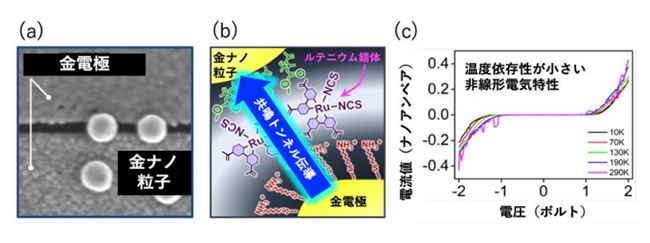Fig.
Nonlinear properties to realize molecular information processing devices clarified
A group of researchers from Osaka University clarified that chemical control of electronic coupling between molecules and electrodes was important in obtaining nonlinear electrical properties, which are necessary for realizing molecular electronic devices.
The human brain can perform efficient information processing with low power consumption. In the neural network in the brain, neurons generate characteristic electrical pulses in accordance with the intensity of a stimulus (nonlinear electrical properties). In the field of molecular electronics, molecular devices in which current changes nonlinearly with the change in voltage applied have been sought after in order to realize efficient information processing that mimics a human brain.
The unique nonlinear electrical properties of molecules are crucial for future molecular electronics. Nonlinear current–voltage (I–V) characteristics can be used in applications, such as molecular diodes, memories, and switches. In order to obtain higher nonlinear I–V characteristics, it is important to understand the relation between the electronic coupling and the nonlinear electrical properties.
Because the resonant tunneling effect produces unique I–V characteristics that exhibit negative differential resistance (NDR), which causes nonlinear phenomena, this group employed resonant tunneling conduction to obtain nonlinear I–V characteristics. In order to control electronic coupling between a ruthenium (Ru) complex and gold (Au) electrodes, they used a nanoparticle (NP) bridge junction, in which AuNPs bridge nanogap electrodes that were modified with molecules, and alkanethiol self-assembled monolayers (SAMs).
As a result, nonlinear electrical properties with a threshold voltage of 1 emerged when Ru complex N-719 was fixed on the electrodes via alkanethiol molecules and the I–V curves showed a rapid current increase above a threshold voltage of ±1.2 V, without obvious temperature dependence. The nonlinear I–V characteristics fit with the direct tunneling conduction model. These findings suggest that the weak electronic coupling between N-719 and Au electrodes is essential to obtain nonlinear I–V characteristics
This group demonstrated that controlling electronic coupling between molecules and electrodes was necessary to obtain nonlinear I-V characteristics. Their research results are helpful in designing molecular devices with nonlinear electrical properties and will lead to the realization of unique nonlinear electrical properties obtained by controlling electronic coupling and the development of brain-inspired information processing systems using such properties.

The article, “Chemical Control of Electronic Coupling between a Ruthenium Complex and Gold Electrode for Resonant Tunneling Conduction,” was published in ACS Applied Materials & Interfaces at DOI: https://doi.org/10.1021/acsami.9b05569.
Related links
Matsumoto Laboratory, CHemical Kinetics and Dynamics, Graduate School of Science, Osaka University











